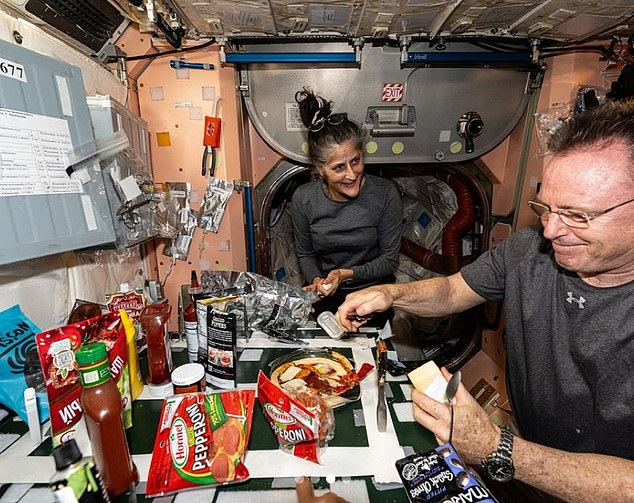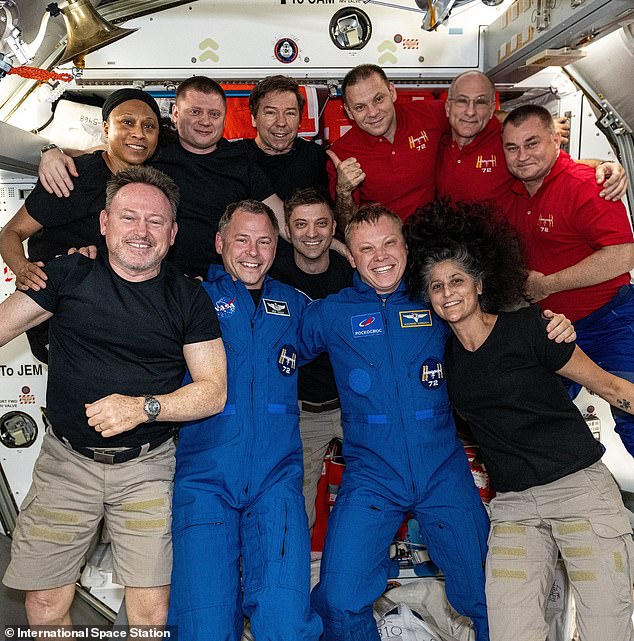Shock photos show physical deterioration of stranded NASA astronaut Sunita Williams
Pictures have revealed NASA astronaut Sunita Williams’ shocking weight loss while she and her crewmate were stuck on the International Space Station (ISS).
Williams, 59, and Barry Wilmore, 61, have been living on the ISS for five months after Boeing’s faulty Starliner spacecraft was deemed unsafe to return them to Earth.
An “emaciated” photo of Williams taken on September 24 recently sparked concern due to her “sunken” cheeks, suggesting she had lost weight rapidly.
More recent images also show her with a pronounced facial structure and a thinner frame – a concern as she still has three months before she returns.
Publicly, NASA has said Williams “remains in good health” and that she has undergone “routine medical evaluations.”
But behind the scenes, the space agency is trying to “stabilize and hopefully reverse the weight loss,” a well-placed source said.
The unnamed NASA employee “directly involved with the mission” told the New York Post that Williams “has not been able to keep up with the high-calorie diets that astronauts are required to consume” while on the ISS.
Long-duration space missions negatively impact the health of astronauts, especially women, and lead to weight loss, muscle wasting, bone loss, heart and vision problems and kidney stones.
NASA astronauts Sunita Williams and Barry Wilmore prepare for the Starliner launch that would take them to the International Space Station on June 5
It has been found that female astronauts lose more weight during space flights – mainly through loss of muscle mass – than men.
‘The kilos have fallen off her and she is now skin and bones. So it’s a priority to help her stabilize and hopefully reverse the weight loss,” the NASA source told the newspaper New York Post.
About a month ago, NASA doctors began working with Williams to help her regain her weight, the source said, even before DailyMail.com’s original story drew attention to her decline.
To halt and reverse her weight loss, Williams would have to eat up to 5,000 calories a day, the source added.
By comparison, the average woman on earth needs to eat between 1,600 and 2,400 calories to maintain her weight. The source said Williams started the mission weighing about 140 lbs.
Williams and Wilmore launched to the orbiting laboratory on June 5 for a 10-day mission, but have been stuck there for 156 days.
Now they’re ready to return to Earth on SpaceX’s Crew-9 Dragon capsule. Williams, Wilmore and the four Crew-9 astronauts will travel home together in February 2025.
By then, the Starliner crew will have spent about eight to nine months on the ISS, depending on when they crash in February.
During that time they will have endured microgravity, close proximity and high doses of space radiation.

A doctor has raised concerns about Williams’ health, claiming she looked ‘thin’ on September 24
Over the past five months, photos returned to Earth have provided a glimpse into the lives of Williams and Wilmore as they adapt to their unforeseen circumstances.
Just hours before the Starliner’s June 5 launch, the crew were photographed in their blue Boeing spacesuits as they prepared for their short mission.
In that photo, the astronauts — especially Williams — look strikingly different than in recent images, including the September snapshot.
That image was one of many posted to the official ISS Instagram page showing Williams, Wilmore and the other ISS astronauts making pizza together.
It recently went viral as the public became concerned about Williams’ shocking performance.
She appears ’emaciated’, said Dr. Vinay Gupta, a pulmonologist and veteran in Seattle, told DailyMail.com earlier this week.
“What you see there in that photo is someone who I think is experiencing the natural stresses of living at very high altitudes, even in a pressurized cabin, for extended periods of time,” he said.
“Her cheeks seem a little sunken – and that usually happens when you’ve had some sort of total weight loss.”
‘BBased on what I see in the photo anyway, I don’t think she’s at all in a place where I’d say her life is in danger.”
‘BBut I don’t think you can look at that photo and say she’s a healthy body weight.”
The NASA source told the New York Post that they were shocked by the image. “I gasped out loud when I saw the last photo,” they said.
“And it’s something we talk about, but not something we’re obsessed with. It’s a real concern and everyone is taking it seriously.”
More recent photos, including one of Williams and Wilmore posing for a group photo with the other members of the Expedition 72 crew on Oct. 4, show Williams still looking thin.
NASA declined to comment on the statements made by the anonymous agency employee and instead referred DailyMail.com back to their original statement claiming that all astronauts aboard the ISS are “in good health.”

Wilmore (front left) and Williams (front right) pose with the other members of the Expedition 72 crew for a photo posted on October 4
The body burns more calories in space as it adapts to changes in gravity and tries to maintain body temperature in cold, harsh conditions.
“They need to eat about 3,500 to 4,000 calories per day just to maintain their current weight,” the NASA source said.
“And if you fall behind, your weight will drop quickly.”
To prevent muscle and bone loss, astronauts exercise about 2.5 hours a day, which burns even more calories.
‘TThere are just things that the human body can’t adapt to, and one of them is that she’s probably losing more calories than she’s taking in,” Dr. Gupta said.
“Her body is probably working harder to do basic things because the partial pressure of oxygen is lower than at sea level.”
The problem of body breakdown is a particular concern for women.
A 2014 NASA study found that women experience greater blood plasma volume loss than men during spaceflight.
And women’s stress response typically includes an increase in heart rate, while men respond with an increase in vascular resistance.
The loss of blood plasma causes your metabolism to temporarily increase while your body mobilizes resources to adapt to the loss of plasma.
And this response can slightly increase your calorie burn, resulting in weight loss similar to what Williams may experience.
Another study published in 2023 by Ball University also found that women lose more muscle mass than men in microgravity environments such as spaceflight.
Williams and Wilmore will have to wait another three to four months before they can return to Earth on SpaceX’s Crew Dragon.
At this time, there is no indication that Williams’ alleged decline in health will impact this timeline.
Although the Starliner mission has been significantly expanded, Williams and Wilmore’s ISS mission will not be the longest ever completed by an astronaut.
That record is held by Russian cosmonauts Oleg Kononenko and Nikolai Chub, who returned to Earth on September 23 aboard the Russian spacecraft Soyuz MS-25 after 374 days on the ISS.
More recently, a crew of four NASA/SpaceX astronauts returned to Earth on October 25 after a 232-day stay on the ISS.
All four crew members were taken to hospital after the splash. Three received a medical evaluation and were discharged that same day, while one was held for overnight observation.
NASA has not released details about why the astronauts needed medical attention, or which of the two was kept overnight.
